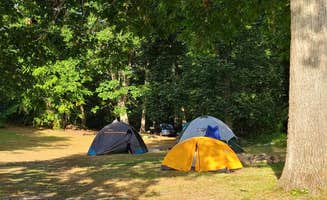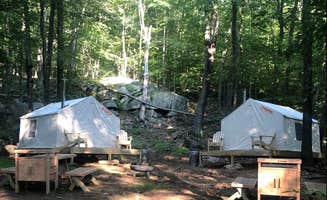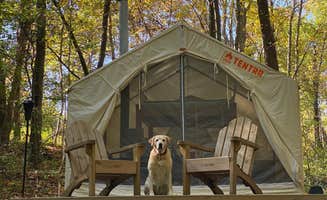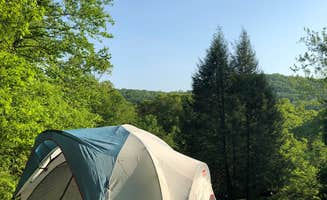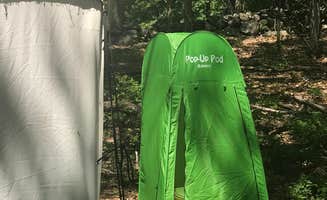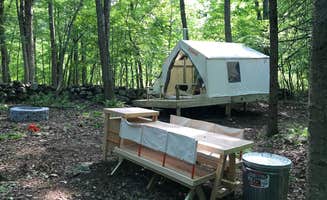Camping options near New Canaan, Connecticut include several state parks and county facilities spread across southwestern Connecticut and neighboring New York counties. Most campgrounds in this region sit at elevations between 200-600 feet, creating relatively flat camping conditions with occasional rolling terrain. Summer temperatures typically range from 60-85°F, while spring and fall camping experiences cooler 45-70°F temperatures with higher precipitation chances.
What to do
Trail exploring near waterways: At Kettletown State Park, campers can access multiple hiking paths with varied terrain. "Beautiful trails, flat & hilly," notes reviewer Trina W., who appreciates the accessibility of paths throughout the park. The park's location offers opportunities for water activities when conditions permit.
Beach access at Long Island Sound: Wildwood State Park provides direct beach access via a downhill walk from the campground. "The beach is fairly clean and has a small boardwalk," writes Giselle P. While swimming is permitted at designated times, be prepared for rocky shoreline conditions. "Beach is beautiful, very rocky, bring your water shoes," advises Ossama B.
Off-season outdoor activities: Winter camping options exist at certain locations like Blydenburgh County Park, which maintains year-round operations. "We visited in late July. Park was excellent... Trails were awesome. Row boat for fishing was great," reports Christopher S. The 7-mile loop trail around the lake provides consistent recreation opportunities regardless of season.
What campers like
Shelter options beyond tents: Many campers appreciate the variety of accommodation structures. "The shelter sites are large and private with access to hiking trails and make for a unique experience," notes Jeremy S. about Ward Pound Ridge Reservation. These lean-to structures provide weather protection while maintaining an outdoor experience.
Spacious sites for group camping: Select campgrounds offer larger sites designed for group gatherings. At Beaver Pond Campground, "The biggest positive about Beaver Pond is how spread out it was. You definitely feel like you have your own space and are not camping on top of your neighbor," according to Ethan K. Many sites feature raised platforms which prove particularly useful during wet conditions.
Proximity to regional attractions: The location between New York City and rural Connecticut provides convenient access to multiple destinations. "We walked 20 min from our site to the beach across the 2-lane highway," reports Jess M. about Clarence Fahnestock State Park. Several campgrounds position visitors within short driving distance of wineries, orchards, shopping centers, and cultural sites.
What you should know
Reservation requirements vary significantly: Many campgrounds require in-person booking with limited advance reservation options. "The reservation process is a bit wonky. You need to call (no online reservations) and then wait for an e-mail," explains Lee D. about Croton Point Park. Always contact the specific campground office for current reservation policies.
Wildlife interactions common: Campers regularly encounter small to medium-sized wildlife. "Keep your food in the dry bag and away from the tent or benches provided or face the packs of fearless racoons at night," warns Anil S. Be prepared to properly secure food and trash, particularly at facilities near water sources.
Seasonal facility limitations: Most campgrounds operate with reduced services during non-peak seasons. "The beach is closed after Labor Day to the public, but open to people staying at the campsite," notes Courtney D. Always check current status of amenities like swimming areas, concessions, and bathhouse operations before planning a trip.
Tips for camping with families
Playground accessibility: Facilities with central play areas provide convenient entertainment options. "Park is excellent. Grounds were as advertised. Family friendly," notes Christopher S. about Blydenburgh Park. Some campgrounds position playground equipment within sight of campsites, allowing parents to monitor children from their sites.
Safety considerations: Most family-friendly campgrounds maintain regular staff presence. "Staff patrols for safety. Good place for families and large groups," reports Melynda M. about Kettletown State Park. These patrols help maintain quiet hours and address any concerns quickly.
Noise levels vary by location and timing: Weekends and holidays typically bring higher visitor numbers and associated noise. "Quiet time at night is laughable as the enjoyment of being in nature rages on into the early morning," reports Steve W. about camping at Beaver Pond. For quieter family experiences, consider midweek stays or early/late season visits.
Tips from RVers
Hook-up availability limited: Many campgrounds offer partial hook-ups with restrictions on electricity amperage or water connections. "RV pull through sites were fantastic. It was a great campground for maiden voyage in new rig. Plenty of amenities," writes Lori R. about her experience at Wildwood State Park. Always confirm specific utilities available at your selected site.
Site configurations vary widely: The landscape creates varied site layouts across different campgrounds. "The sites are much farther away from the comfort stations than most campgrounds we have been to," notes Ming R. Larger RVs should verify access routes and turning radius requirements before booking, as many regional campgrounds were designed for smaller units.
Shoulder season advantages: Spring and fall camping offers reduced crowding and often more available sites. "Off-season, mid-week retreat... The campground was clean and quiet. RV hook-ups, tent platforms, and rustic tent sites were available," writes Rebecca S., highlighting the benefits of avoiding peak summer weekends.


